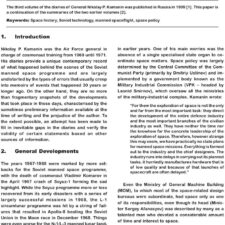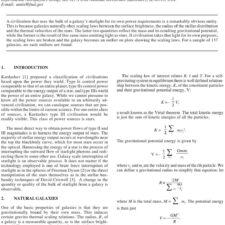Applied-Field Magnetoplasmadynamic Thrusters (SUPREME) as an Enabling Technology for Next Generation of Space Missions
£5.00
M. La Rosa Betancourt et al. (2019), JBIS, 72, pp.401-409
Refcode: 2019.72.401
Abstract:
This paper discusses the latest developments in the field of Applied-Field Magnetoplasmadynamic Thrusters (AF-MPDT), particularly regarding the integration of high-temperature superconductors (HTS) as part of the SUPREME project, and their role as an enabling technology for high-power space missions. AF-MPDT technology is compared with status quo Electric Propulsion Systems (EPS) in the context of the following mission scenarios: Satellite Servicing in the near-Earth environment; Cargo missions to the moon and Mars; and crewed Mars flight. The impact of the choice of propulsion system on the mission cost is reported, and the corresponding impacts on feasibility are discussed. The results of this exercise demonstrate that the use of AF-MPDTs incorporating HTS-based subsystems can increase the feasibility of these missions. As satellites become larger and ΔVs increase, the impact of the propulsion system choice becomes increasingly important. For many proposed missions, the use of chemical systems becomes impractical and prohibitively expensive due to large propellant mass fractions. While current EPS offer a high specific impulse (Isp) solution, high powers are required to produce sufficient thrust for reasonable mission timescales. A high-power EP system from 20 to 100 kW, able to scale up to the MW range without compromising on Isp and power density is needed to realize the foreseen mission scenarios. The characteristics of AF-MPDTs are most suitable for missions requiring fast transfers of heavy payloads at an acceptable exhaust velocity. They provide the highest thrust per plume surface area of any EPS alongside superior scalability to high powers, thus avoiding the need for impractical clustering configurations of several units. The throttling capability of AF- MPDTs allows the same thruster design to operate at the optimum exhaust velocity for any given mission profile, and their propellant flexibility expands several mission possibilities through the use of in-situ resource utilization. While AF-MPDTs have been researched around the world for several decades, their adoption as a flight system has been hindered by the large mass of the electrical components required for the Applied-Field module. The use of HTS neutralises this issue by providing current densities on the order of 100 times as large as before, allowing larger magnetic fields to be generated while minimising mass. Furthermore, the higher magnetic fields enable operation at higher discharge voltages and thus lower discharge currents, thereby increasing the lifetime of the thruster while maintaining performance. In conclusion, the fusion of AF-MPD and HTS technologies will allow applications to a wide range of mission scenarios, thus acting as an enabling technology for the wider space industry.





